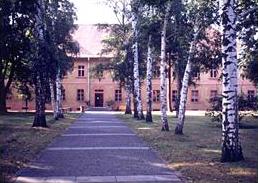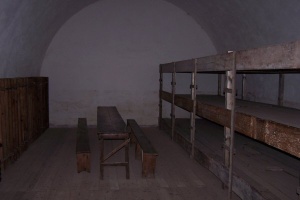Terezin Memorial tour
You can see:
|
|


Left side: administration building, right side: mass cell in the 1st court-yard
Origin: www.pamatnik-terezin.cz
Price of Terezin Memorial tour
1-4 pax. / sedan 44 EUR + waiting
5-8 pax. / minivan 55 EUR + waiting
9 pax. and more ask us
- Price here includes transfer, the waiting 200 CZK / 8 EUR / hour is NOT included.
- Price is per car, not per person.
Entrance fee: 200 CZK / person (discounted for children, seniors )
- For more information contact our ATP Airport Transfer Prague operator or call our office: +420 728 876 876
Terezin
Terezín was established at the end of the 18th century as a fortress; still surrounded by its massive ramparts, the town lies at the confluence of the rivers Labe (Elbe) and Ohře (Eger). The Main and Small Fortresses at Terezín, although the modern for their period, gradually became obsolete, and having lost their military function fell into disregard.
Only in the relatively recent past has Terezín once again entered the worlds public consciousness as a tragic symbol of the sufferings of the tens of thousands of innocent people who died here during the Nazi occupation of their homeland.
The Police Prison in the Small Fortress
After Hitlers occupation of Czechoslovakia, the Nazis recognised the advantages of the Small Fortress, and in June 1940 opened a police prison within it. Czech and Moravian patriots, members of numerous resistance groups and organisations, were sent here by various branches of the Gestapo.
While around 90% of the inmates were Czechs and Slovaks, others included citizens of the Soviet Union, Poles, Yugoslavs, Frenchmen, Italians, English prisoners of war and other nationalities. In five years, some 32 000 men and women passed through the gates of the Small Fortress.
The conditions under which the prisoners lived worsened from year to year, and prisoners were forced into slave labour. The internal komando maintained the prison, tilled the surrounding fields and built various structures. The majority of prisoners, however, worked outside the fortress for various firms in the area, and until the closing days of the War contributed to production and work for the Reich.
From 1943 executions, too, were carried out in the Small Fortress, on the basis of Sonderbehandlung - without judicial process. In all, more than 250 prisoners were shot. At the last execution, on May 2nd 1945, 51 prisoners and 1 informer, mostly representatives of the Předvoj youth movement, lost their lives.
Only in the evenings, in moments of rest, could the prisoners rise above the never-ending humiliation and terror from the side of their guards. Within their cells, permanent and trustworthy collectives formed that secretly organised political and cultural events. Talks and presentations were held by artists and a broad range of professionals; in some cells cultural evenings were secretly held with singing and recitations, and clerics organised prayers. Even in such inhuman conditions people were able to express their creativity; numerous poems and simple drawings of outstanding documentary value originated here. Culturally, political life in the cells and secret links to the outside world helped the prisoners to overcome the horrors of this tool of Nazi persecution.
Among those imprisoned in the Small Fortress were the head of the resistance organisation the Central Command of Home Resistance, doc. Vladimír Krajina, the most senior officers of the National Guard, Generals Hugo Vojta, František Kravák, Viktor Spěváček and František Melichar, and the head of the Czechoslovak General Staff, General Ludvík Krejčí, who was also deported here. Also present were the leader of the Věrni zůstaneme (We remain faithful) petition movement Prof. Vojtěch Čížek, the writer K.J. Beneš, the editor Otakar Wünsch and JUDr. Milada Horáková. Members of the Communist Party imprisoned here included Václav Sinkule, Eduard Urx, MUDr. Miloš Nedvěd, Milada Pixová and Marie Zápotocká. After the assassination of Heydrich in 1942, students from Roudnice were brought here, along with the relatives and accomplices of the assassins, Kubiš and Valčík; of these, 252 were executed in October 1942 at Mauthausen. Other prisoners of note included the Prague radio reporter František Kocourek, the caricaturist František Bidlo, the former Minister of Foreign Affairs Kamil Krofta (a university professor and historian), and prof. Karel Štipl.
The Small Fortress had the character of a transit prison, from which inmates were after a certain period either brought before the courts or transferred to concentration camps. As a result of hunger, maltreatment, insufficient medical care and poor hygienic conditions, however, some 2600 prisoners died here, while thousands more lost their lives having been deported from Terezín.
The concentration camp for Jews - the Terezín Ghetto
An integral part of Nazi plans for a new ordering of Europe was the so-called Final Solution of the Jewish Question. From the occupied territories of Bohemia and Moravia, too, citizens of Jewish origin were hunted down and, from November 1941, gradually deported to the town of Terezín (the Main Fortress), where the Nazis arranged a ghetto for them. Here they were to be massed until the extermination camps further east were ready to carry out their final liquidation.
Initially, the barracks in the town were used to accommodate the Jewish prisoners, and once all the local residents had been moved out, by mid-1942, all civilian buildings were sued for this purpose. Massive overcrowding, however, also led to the use of attics, cellars, and the casemates within the ramparts. Terezín became the largest concentration camp in the Czech Lands, with thousands of transports arriving here carrying Jews not only from the Protectorate of Bohemia and Moravia, but also from Germany, Austria, Holland and Denmark, as well later as from Slovakia and Hungary.
In less than four years, more than 140 000 prisoners were brought here - men, women and children. In the last days of the War, a further 15 000 prisoners arrived at Terezín on evacuation transports from concentration camps cleared from the advancing front line. Over 35 000 prisoners died here as a result of stress, hunger, and the atrocious accommodation and hygienic conditions.
The Terezín camp for Jews was headed by a Nazi Komandantura, which gave instructions to the Jewish authority which took care of the internal organisation of the camp. Direct supervision of the prisoners was left to the Protectorate guards, the great majority of whom sympathised with the prisoners, attempted to help them and kept them in touch with the outside world.
Within the camp, all manner of prohibitions and ordinances applied, and only cultural life was for a certain period permitted, as it could serve as a backdrop disguising the truth of the fate that had been decided for the Jews. The internees took up the arts as a means of coping with depression and their fears for the unknown future. They attempted to ensure that even imprisoned children missed nothing of their education, and did not lose their outlook. Despite Nazi prohibition, therefore, they taught in secret, dedicating themselves with great self-sacrifice to educating the children; even behind the walls of the ghetto, they prepared them for a future in freedom.
Unfortunately, even as transports arrived at the ghetto, others gradually began to leave - into the unknown. From October 1942 virtually all went to Auschwitz-Birkenau, the most awful of the extermination camps. In all, 63 transports left Terezín for the East, carrying a total of more than 87 000 individuals; of these, only 3800 would see liberation. The fate of the children of Terezín was equally tragic; of the 7590 youngest prisoners deported, a mere 142 survived until liberation. Only those children who remained for the whole period at Terezín had any really chance of being saved; on the day of liberation, Terezín contained some 1600 children aged 15 or under. Their lives are reflected in verses, diaries, illegally produced magazines and thousands of drawings - often the only things that remain of them.
Among the personalities active in the cultural life of the ghetto were the writers Karel Poláček and Norbert Frýd, from the world of music Karel Berman, David Grünfeld, Ada Hechtová, Karel Ančerl, Rudolf Franěk, Karel Reiner, Viktor Ullmann, Gideon Klein, Pavel Haas, Hans Krása and F.E. Klein, from theatre and cabaret arch. František Zelenka, Gustav Schorsch, Vlasta Schönová, Karel Švenk, Zdeněk Jelínek, Ota Růžička, Kurt Gerron, Hanuš Hofer, and Leo Strauss, and from the arts Bedřich Fritta, Otto Ungar, Leo Haas, Ferdinand Bloch, Karel Fleischmann, Petr Kien, Adolf Aussenberg, Charlota Burešová, Rudolf Saudek, Jo Spier and Arnold Zadikow.
Origin: www.pamatnik-terezin.cz
Ski Resorts
Nice mail from Richard
22.8.2017 I am happy to read e-mails like this.
Dinner with the Folklore
New pictures of cars
20.8.2013 New pictures of car fleet Airport Transfer Prague. Prague Castle square, 2013.